Last updated: October 19, 2023
Article
Changing Attitudes
Most women with disabilities hired by the National Park Service (NPS) in the 1970s and early 1980s had temporary jobs. Some built long-term careers with the bureau. Starting before the Americans with Disabilities Act of 1990, these women experienced the opportunities and changes the law brought. It was their hard work and dedication to the NPS mission, however, that continued to change attitudes and educate coworkers and visitors alike.
Words Matter
The language used to describe people with disabilities and their specific disabilities has changed over time. Some words commonly used in the past are now broadly recognized as offensive or belittling toward persons with disabilities. In this article archaic terms that are part of titles, direct quotes, or integral to the point being made have been retained for historical accuracy. In all other instances, however, the terminology has been updated to reflect current standards of respect and inclusivity.
Building a Home with the NPS
In the case of Martha Chapman, her NPS job was a long time coming. Because she was deaf and didn’t speak, setting up job interviews, asking questions about applications, and communicating her skill sets were difficult. She had been out of work for 16 years before the NPS hired her as a custodian in the maintenance division at Ocmulgee National Monument (now Ocmulgee Mounds National Historical Park) in 1984.
Chapman and her work ethic were praised by her supervisors and colleagues. She worked at the park for at least 15 years. In 1998 park employees helped her qualify for a Habitat for Humanity house, and many helped built the house on their own time. That same year the park was recognized as the “Small Employer of the Year” by the Mayor’s Commission for Disability Issues and the “Employer of the Year” by the Deaf Awareness Committee for its personal and professional support of Chapman. Although the details of her career are spotty, she was still working for the park in 1999. No photographs of her have been found to date.
Curating a Career with the NPS
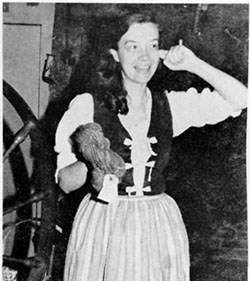
Cathy Lennon Ingram graduated from Gallaudet College, a school for the deaf in Washington, DC, in 1975. She joined the NPS in 1978, working as an interpreter at the Old Stone House in Washington, DC. She used sign language to communicate as she demonstrated what life was like in the 1700s. In keeping with her living history work, she wore a period costume rather than the NPS uniform.
Ingram went on to become the museum curator at Frederick Douglass National Historic Site. Among other work, she coordinated a project to conserve 2,000 books from the park's collection.
Throughout her career, Ingram provided opportunities for interns and volunteers who were deaf. At the Old Stone House, it was as part of an apprentice program for girls 10 to 14. As curator, she offered internships working with the museum collection. Suzanne Warwick, a Gallaudet student, interned with Ingram in 2009.
Ingram retired in 2011, after 36 years of service.
Dispatches from Lake Superior
Lynda Anne Reynolds attended the Perkins School for the Blind in Boston, and Orange Coast College in California. She earned a BA in sociology from Pepperdine University. She was teaching children with disabilities in California in 1985 when she met Doug Boose, a ranger at Isle Royale National Park, at a skiing event in Colorado. Boose was assigned as her sighted guide. They hit it off and were married in 1986.
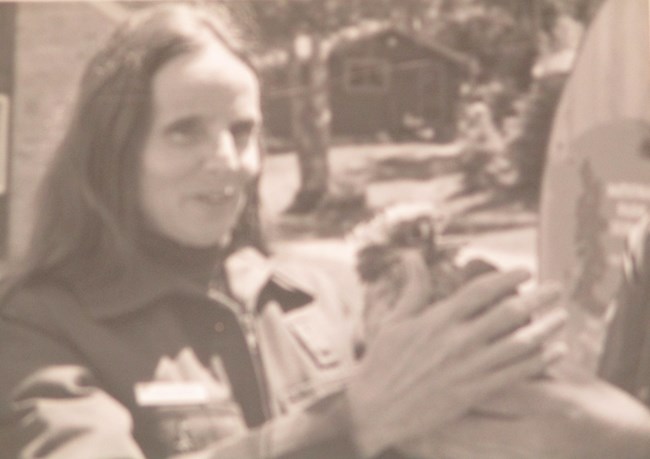
Describing the 1987 start of her NPS career Boose wrote, “I did not work my first summer on the island but the next summer I heard that the park was looking for a part-time dispatcher. I felt I could do the job and went and talked to the chief ranger. We discussed dispatcher duties and talked about how I could do them. The rest is history. I was hired part-time, which was two days a week.” Asked recently if she thought that she would have been hired if she hadn’t already had a connection to the park, she responded, “I was in the right place at the right time. I lived there. But I don’t think I would have been hired if I just applied in the usual way.” She recalls that Chief Ranger Stu Croll was very supportive and an advocate who treated her “the same as the rest of the rangers.”
In 1988, Boose became the permanent dispatcher, although the position was subject to furlough. That year she represented the United States as a member of the ski team in the Fourth World Winter Games for the Disabled, the Paralympics held in Innsbruck, Austria. She was also the only woman Nordic skier who was completely blind to compete for the United States and came in seventh in the women’s 10K and eighth in the 5K races. Her husband Doug was her sighted guide during the competition.
As dispatcher she monitored and responded to park radio traffic, including the marine radio, and answered telephones. During medical emergencies she relayed messages from NPS emergency medical technicians and called doctors. She also handled the park’s mail, taking it to the mail boat that came three times a week, and tracked lost and found items.
Boose used specialized equipment to help her do her job including a computer with voice output, a light sensor for telephones, a tape recorder, and a Braille writer. She also used an Optacon to read printed materials that hadn’t been transcribed into Braille and to fill in forms before computerized templates were available. She developed a system for organizing and tracking the lost and found items that didn’t require much assistance from a sighted person. She also created a phone message form on the computer to relay messages and labeled all the mailboxes in Braille so she could put the messages in the correct location.
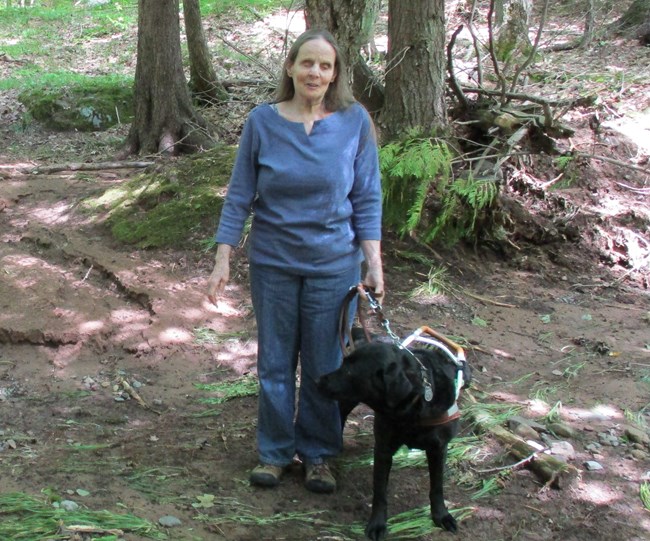
Until around 1997, Boose and her husband lived on the island in the park for six months each year and in Houghton, Michigan, the rest of the year. When they moved to town year round, and she took a visitor services job in the visitor center. Boose was laid off for several months each year during slow seasons, and she “liked it that way” because it gave her time to pursue her other interests. In that role, she helped visitors plan their trips, took reservations for the NPS boat Ranger III, answered visitor questions, and learned to use the cash register, often with visitors’ help. Eventually a talking cash register made her job easier. She recalls that “visitors were amazing” in helping make their purchases, reading off the codes on the books she needed to enter.
Boose’s guide dog Blondie accompanied her everywhere. She doesn’t recall anyone every being upset or challenging Blondie’s presence, although at the visitor center she remained in the office because there was little space behind the counter. Blondie was an excellent hiking companion, and together they hiked trails throughout the park.
Boose wore the NPS uniform as both a dispatcher and while working in the visitor center. She recalls her pride at putting it on the first time. Her biggest challenge with it was to ensure that she didn’t put her name tag on upside down. To ensure she didn’t, she added her own label in braille on the back to indicate the top. She worked for the NPS for more than 15 years, retiring around 2003. Boose was the inspiration for a character in Nevada Barr’s park-inspired 1994 novel A Superior Death.
“Let’s See What I Can Do”
Erin Broadbent also built a career in the NPS. Her father, Jack Broadbent, worked in the NPS for 32 years and was superintendent of Tonto National Monument. Broadbent grew up in Crater Lake and Carlsbad Caverns national parks but graduated from high school in Arizona. Her uncle, Bud Hanify, was also a park ranger. Although she thought she might work seasonally with the NPS, she didn’t expect to have a career with the bureau.
In August 1977, the week before she was to leave for college, an accident at a swimming hole left Broadbent paralyzed from the chest down and with only limited use of her left hand. In a 1999 interview in the Charlotte Observer, Broadbent recalled getting the news from her doctor and responding, “OK, you’ve told me what I can’t do. Now let’s see what I can do.” She was expected to be in hospital for a year; she was discharged after four months.
She entered Arizona State University in 1978, largely because its campus was accessible. She volunteered to do administrative tasks in the office at Montezuma Castle National Monument during summer 1980. The next summer she was hired there in a part time position. Those experiences made her realize she did want an NPS career. She graduated with a BA in recreation resource planning and management in 1982. A job opened at Tumacacori National Historical Park that same year. The full-time position was split seasonally between administration and interpretation. She was the first woman with disabilities in that position. She received the first of many promotions in her NPS career after just 90 days in the position.
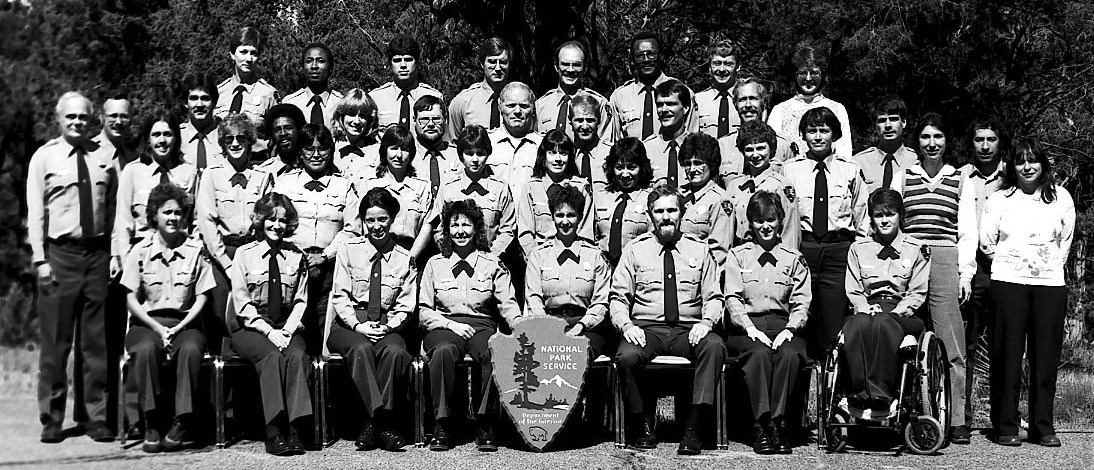
In May 1984 she transferred to Presidents’ Park as the lead park technician, organizing tours of the White House grounds. She was the first woman with disabilities in that position as well. In an 1985 oral history interview co-worker Regina Jones-Underwood recalled that working outdoors all day in the cold, heat, and rain was physically difficult for Broadbent. During the worst weather, co-workers would offer to cover for Broadbent so she could go inside. She wouldn’t hear of it. As Jones-Underwood remembers it, Broadbent said, “No, this is my position. I asked for it. I have it. I can deal with it.”
In spite of her tenacity, Broadbent noted in 1985 oral history interview that, “I don’t like to think that the chair would ever stop me from going someplace. But I have to take into account, you know, it’s not going to be easy to get around in 12 feet of snow in a wheelchair.” Weather aside, she stated, “I feel good when people see me out there. And I feel good in my uniform.”
Occasionally she ran into “ hard-headed people who say, ‘Well, we can’t make that accessible’ or ‘We can’t do that because it costs too much.’ And accessibility does not have to be expensive.” Broadbent also met some NPS employees who saw her disability instead of her abilities. She noted, “I have a real hang up with people who say ‘Hey, you got your job because you’re in a chair.’ They say, ‘Well you got it going for you, you’re in a chair, you’re a woman.’ And I say, ‘Hey, I got my job because of my abilities.”
She continued, “I don’t let the chair get in my way [but] I don’t like to use my wheelchair to get anywhere, to quote, ‘to move up the ladder’ or anything. I have never liked that.”
She completed the NPS ranger skills training at Albright Training Center in fall 1985. She left President’s Park in 1986. Jones-Underwood recalls that visitors loved Broadbent, noting that she had a sense of humor and didn’t take offense easily which put visitors and other staff at ease. Her “going-away present” from the US Secret Service was a 20-minute visit with President Ronald Reagan in the Oval Office.
Broadbent reflected that her disability “helped in the areas that I’ve been in. I think it’s helped the employees be more relaxed around visitors who are in chairs. It’s made their areas much more accessible.” Although she thought it would be “neat to work in as many parks as possible,” early in her career Broadbent promised her father she would stay at least two years in any place she worked. As a superintendent, he “never felt like he got the worth of people he employed unless they stayed for at least two years” and she took his lesson to heart.
She became a coordinator for the NPS Federal Women's Program in the 1980s. She also worked in the NPS International Affairs Office organizing tours and seminars for foreign officials looking to start national parks in their home countries. In 1992, she became site manager of the National Mall. In that position she not only managed daily operations but also coordinated significant special events like a presidential inaugural and the annual Fourth of July fireworks.
In 1999, at age 40, she became the first woman superintendent of Kings Mountain National Military Park. She was also the first person in a wheelchair promoted to a superintendent position. In discussing her appointment, Broadbent shared her philosophy in an interview, stating, “If you put up roadblocks, you’ll have roadblocks. I just never put up any. I still do everything I did before my accident. I just do it differently.” Broadbent retired from the NPS in 2014.
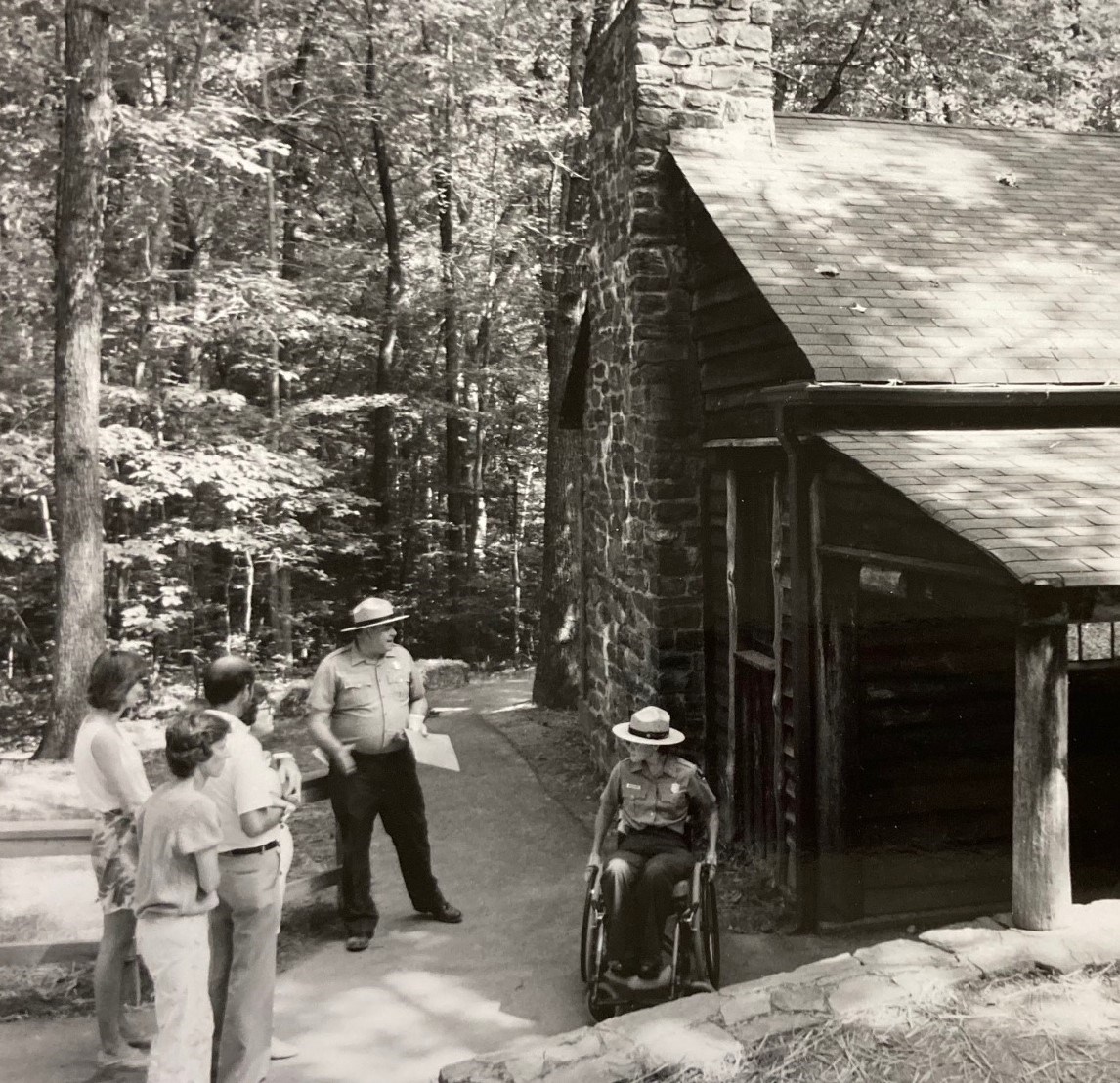
Advocating for Universal Interpretation
Shirley Anne Beccue was a senior at Northern Illinois University when she had a toboggan accident that left her paralyzed from the waist down. A 2005 interview quotes Beccue saying, “It was important that people didn’t think it (the paraplegia) was the end of the world and they thought I’d have a life. My father’s attitude was, ‘you’re hurt, yeah, but you’ll have a job and get on with it.’” She was in hospital for a year following the accident but went on to complete an art education degree at the University of Illinois, where she had transferred to because of its accessible facilities.
Following college, Beccue bought a nursery school in Florida that she ran for 10 years. She credits this experience in helping her become comfortable with herself after the accident. She recently explained, “Children are open and curious about what its like to have a disability. They would ask stuff that adults only wondered about.” These experiences helped her overcome “feelings of awkwardness” and prepared her for her next career.
Looking for a change at 34, she began working for the NPS as a seasonal naturalist at Everglades National Park in 1979. The position was part-time and on “a trial basis.” Like other seasonal naturalists, she worked half days in the visitor center and gave interpretive walks and lectures the rest of the time. Everglades’ flat terrain and boardwalks into the wetlands were easier for Beccue to navigate in her manual wheelchair. The temporary position led to a permanent position as a front-line interpreter. She spent most of the next decade as an interpreter at the park. In 1983 she led efforts to upgrade one of the park’s “chickees” to provide an accessible backcountry campsite.
By 1984 she was working under the title of park technician. In April–May 1985 Beccue completed the NPS ranger skills training at Albright Training Center at Grand Canyon National Park. She recalls being the first paraplegic to participate in the repelling exercises that were a standard part of the course’s the search and rescue training. She also completed the “zip line” challenge, assisted in “carry out” drills for injured visitors, completed law enforcement scenarios, and used a fire hose. She chose not to go to the bottom of the Grand Canyon, although there was an offer to take her down in a helicopter. The buses used to visit other parks during the course weren’t accessible but Beccue always have offers from others to help her where needed. She recalls, “People were very accommodating and I always felt like part of the group.”
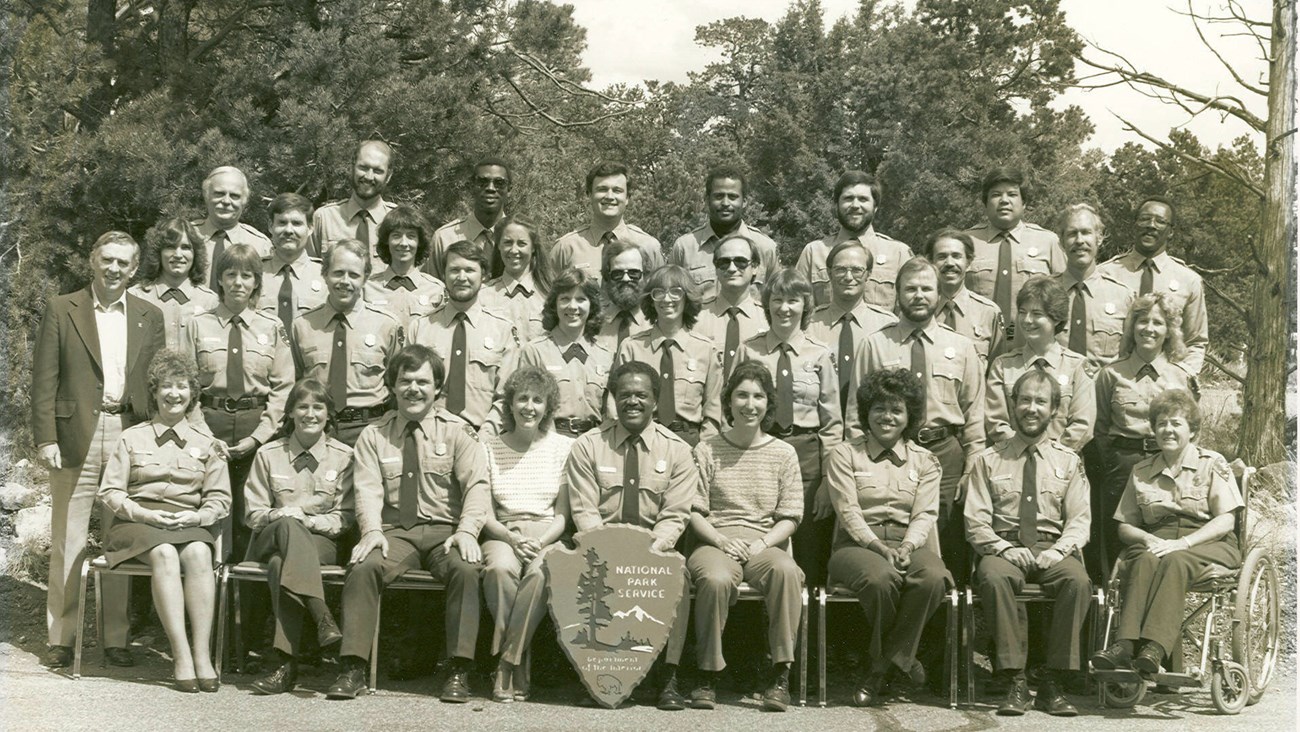
Beccue lived in park housing while at Everglades. Although the unit was single story, it required modifications. She recalls, “They added a good size ramp at the front door and a smaller one from the living room to the screened in porch. The bathroom door was narrower than my wheelchair but I had a device on my chair that would pull the chair together so I could get into the bathroom. I would unwind the device once I was in the bathroom and open the chair out again. There was an air conditioner mounted high on the living room wall. One of the maintenance fellows devised a wooden stick with a metal “claw” at one end that fit perfectly around the control knobs. It worked great.”
She didn’t need to make any modifications to the NPS uniform but chose a shorter jacket or sweater option in cooler weather as long coats aren’t practical or comfortable with a wheelchair. She recalls that Sandy Dayhoff and Deb Wade from the park’s environmental education program were advocates for persons with disabilities as well as her life-long friends. Beccue coordinated training and audited other rangers’ programs to help them develop inclusive programs, improve their skills in presenting information, and interact with visitors in ways that put everyone at ease.
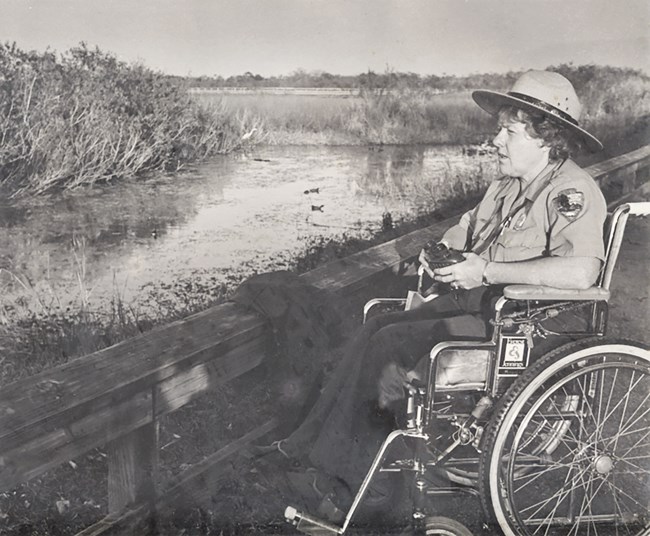
She left the Everglades to become supervisory park ranger at Acadia National Park in May 1989. Both parks installed hand controls in the government vehicles so that Beccue could drive as needed for her job duties.
In addition to her other ranger duties at Acadia, Beccue started the park’s artist-in-residence program. She also trained park staff about access and universal interpretation. She remarked, “I do an access session every year in which we talk about how to include all of the audience. For example, don’t talk and walk at the same time. Look for signs that someone might be straining to hear or see. Place yourself level with the listener. Read your audience and adjust accordingly. For example, an interpreter might take a short walk off trail to point something out but they need to rethink the off-trail segment if someone in the group appears to have a mobility impairment. But most importantly, don’t make assumptions. Ask when unsure.”
Beccue became assistant chief of interpretation and in 1998 Friends of Acadia awarded her a Distinguished Public Service Award for her “productive, calm, and always friendly way in working with others” in her job. In a 2005 interview around the time of her retirement, Beccue was asked whether the NPS had changed during her 17 years at Acadia in terms of accessibility. She responded, “It really depends on personnel. My chief here is very supportive. Overall, there’s real support here and a real awareness.”
Moving Forward
These women and others demonstrated that people with disabilities could have meaningful employment with the NPS and excel at their jobs. They fostered evolving attitudes in other employees while creating opportunities for themselves and others. The passage of the Americans with Disabilities Act (ADA) in 1990 would usher in more protections and provide additional opportunities for more women with disabilities to have careers in the NPS.
Explore More!
To learn more about the history of women and the NPS uniform, visit Dressing the Part: A Portfolio of Women's History in the NPS.
This research was made possible in part by a grant from the National Park Foundation.
Tags
- carlsbad caverns national park
- crater lake national park
- everglades national park
- isle royale national park
- kings mountain national military park
- montezuma castle national monument
- national mall and memorial parks
- ocmulgee mounds national historical park
- the white house and president's park
- tonto national monument
- tumacácori national historical park
- women's history
- accessibility
- nps history
- nps history collection
- nps uniforms
- hfc
- nps careers
- disability history
- deaf history
- deaf women
- deaf awareness
